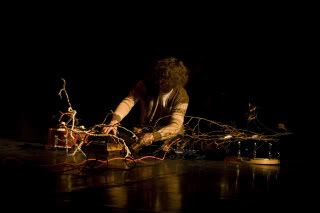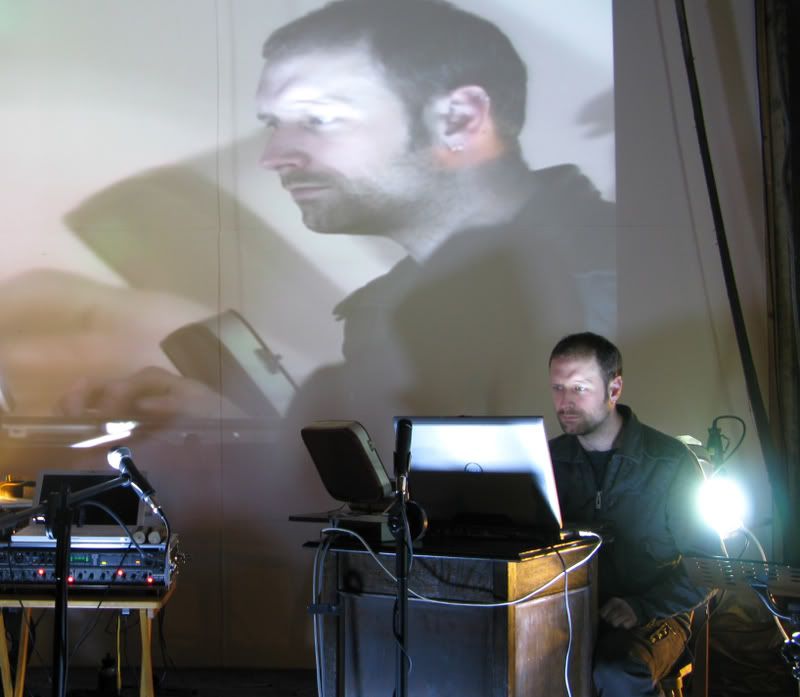February Events
----------------------------------------------------------------------------------------------------------------
• Jez riley French & Patrick Farmer
• Simon Whetham
• ‘Shanghai’ by Carpets Curtains (15 mins)
• ‘Ragtag’ by AVVA (Billy Roisz & Toshi Nakamura) (5mins)
• ‘Sources’ by Billy Roisz (video) with Andrea Neumann, Annette Krebs, Axel Dörner, Martin Siewert, Martin Brandlmayr, Otomo Yoshihide, Rossi, Sachiko M (12 mins)
------------------------------------------------------------------------------------------------------------------
Individual Biographies

Jez riley French sounds like;
Intuitive Composition. Field Recordings. Objects. Surfaces.
Jez riley French has performed, exhibited and published widely across Europe. He lectures on field recording & intuitive composition & also runs the engraved glass label, the ‘in place’ blogspot & the seeds & bridges concert series in Yorkshire.
http://JezrileyFrench.blogspot.com
http://JezrileyFrench-inplace.blogspot.com
http://www.myspace.com/JezrileyFrench
http://engravedglass.blogspot.com
-------------------------------------------------------------------------------------------------------------------

Patrick Farmer sounds like;
The lightness of pine cones and other natural objects vibrating on a tightened synthetic skin.
Patrick Farmer has played with Kevin Shea, Helena Gough, Okkyung Lee, Dominic Lash, The Good Anna, Angharad Davies, Matt Davis, Rhodri Davies. He has a handful of releases coming out soon on labels such as Creative Sources, Why Not LTD of Malaysia, organised music from Thessaloniki, and also co-runs the label compost and height.
www.myspace.com/woodandwhisks
www.compostandheight.blogspot.com
------------------------------------------------------------------------------------------------------------------

Simon Whetham sounds like;
'...a novelist' - Rinus van Alebeek, Berlin, 2008
The description Rinus gave Simon and his approach to composing using field recordings is perfect. His recorded and performance pieces are episodic, dramatic and evocative.
Simon's work has led him to record and perform in Iceland, Mongolia, France, Germany, Brazil and Estonia, and to perform alongside artists such as Fennesz, Philip Jeck, The Owl Project, Mira Calix, Plaid and Hauschka, to name but a few.
He has had work released by Entr'acte, Trente Oiseaux, Gruenrekorder, Earth Monkey and Filament, with upcoming releases through Lens Records and 1000fussler.
www.simonwhetham.co.uk
www.myspace.com/simonwhetham
-------------------------------------------------------------------------------------------------------------------
Carpets Curtains – ‘Shanghai’ (15 mins)
Combining live audio “micro-improvisations” (refined by architect Ivan Palacky) with live video manipulations (by visual artist Filip Cenek aka VJ Vera Lukasova), Carpets Curtains express an engaging and nuanced interplay of audio and visual material. With live visuals being based on improvised memory re-edits in which emphasis is placed on ambiguous “narration” whilst VJ software errors are used to reach new amoebic image qualities, the result is a principle or method of remaining fixed to moving images while vacating the essential aspects for building concrete meaning. Such visual approaches find parallel in Palacky’s delicate musicalities, in which found objects and minimal electronics are fused to create elegantly small sound mixtures.
AVVA (Billy Roisz & Toshi Nakamura) – ‘ragtag’ (5mins)
"Ragtag" - in the sense of impenetrable, a colourful mixture - is the title of a joint work by Billy Roisz (visuals) and Toshimaru Nakamura (sound) which was created under the project name AVVA after a 2004 tour in England. Impenetrable and a mixture also describes the work principle behind "ragtag" well: At first there´s the sound of Nakamura´s mixing board by itself, without external input. Its musical inner workings turn gloomy and skeleton-like, stripped bare by recursive feedback loops. This is input into Roisz´s video mixer and becomes a part of its generation of images, which is no less recursive and self-reflexive than the sound design. The result is colourful, shimmering and impenetrable ?between reduced sound and an extensively emptied picture, between a skeletal rhythm and a matrix of video lines, a combination composed in such a way as to be less audiovisual than "technovisionary." The visionary mixture remains within rigid geometric framing: A minimalist rhythm begins, revealing a pattern of lines and stripes, at first solely its top third is in motion. It flickers and hums - in microtones or at high frequency - until a continuous basic pattern covers the entire picture. While the volume of Nakamura´s thumping feedback is gradually lowered, the clicking pulses have infected the entire structure of the image. A tachycardian aesthetic, both roughly trembling and finely chased, has come into being, and it is reflected in distant worlds of sine waves. The feedback concentrate is not removed in its entirety, as a monochrome structure of stripes is superimposed over the picture at the end. Possibly not as colourful, but still impenetrable. (Christian Höller)
Billy Roisz (video) with Andrea Neumann, Annette Krebs, Axel Dörner, Martin Siewert, Martin Brandlmayr, Otomo Yoshihide, Rossi, Sachiko M (sound) – ‘Sources’ (12 mins)
For 'Sources' the solo soundchecks of eight musicians were recorded - sounds and video were saved seperately. The idea was to follow the paths of musical creation processes (and their corresponding visual techniques) and develop a video, starting with soundcheck-footage, to a complex result. In the first stage the physical events that govern the production of sounds and take place for the most part "behind the scenes" have been visualised by entering the microcosm of acoustic phenomena via macro shots. The collected material served as an image and sound archive, and was the basis for the montage. The shots were synchronised with the soundtrack (aligning each sound source to the corresponding film sequence). The film/music miniatures produced in this way were then used as the source material for the final composition, partly pacifically coexisting, partly cheekily demanding for space. The single miniatures seem to be looking for collaborations, solo parts and rest. The result is a dramatic composition that evolved from the raw sources of sound-check materials during the process of investigating the possibilities and nature of audiovisual creation and perception.



No comments:
Post a Comment